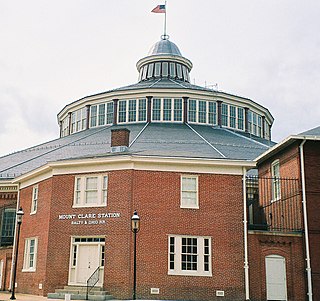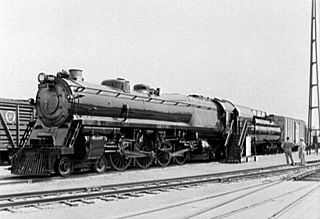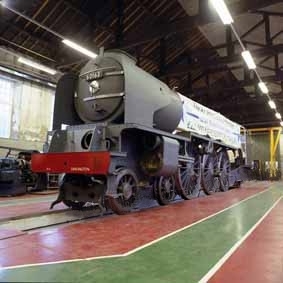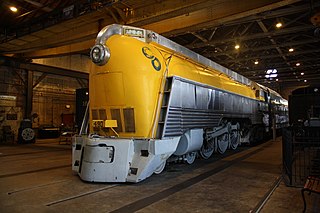
The Baltimore and Ohio Railroad was the first common carrier railroad and the oldest railroad in the United States. It operated as B&O from 1830 until 1987, when it was merged into the Chessie System; its lines are today controlled by CSX Transportation.

Under the Whyte notation for the classification of steam locomotives, a 2-10-4 locomotive has two leading wheels on one axle, usually in a Bissel truck, ten coupled driving wheels on five axles, and four trailing wheels on two axles, usually in a bogie. These were referred to as the Texas type in most of the United States, the Colorado type on the Burlington Route, and the Selkirk type in Canada.

A 2-8-8-4 steam locomotive, under the Whyte notation, has two leading wheels, two sets of eight driving wheels, and a four-wheel trailing truck. The type was generally named the Yellowstone, a name given it by the first owner, the Northern Pacific Railway, whose lines ran near Yellowstone National Park. Seventy-two Yellowstone-type locomotives were built for four U.S. railroads.

The B&O Railroad Museum is a museum and historic railway station exhibiting historic railroad equipment in Baltimore, Maryland. The Baltimore and Ohio Railroad (B&O) company originally opened the museum on July 4, 1953, with the name of the Baltimore & Ohio Transportation Museum. It has been called one of the most significant collections of railroad treasures in the world and has the largest collection of 19th-century locomotives in the U.S. The museum is located in the Baltimore and Ohio Railroad's old Mount Clare Station and adjacent roundhouse, and retains 40 acres of the B&O's sprawling Mount Clare Shops site, which is where, in 1829, the B&O began America's first railroad and is the oldest railroad manufacturing complex in the United States.

A 4-4-4-4 steam locomotive, in the Whyte notation for describing locomotive wheel arrangements, has a four-wheel leading truck, two sets of four driving wheels, and a four-wheel trailing truck. While it would be possible to make an articulated locomotive of this arrangement, the only 4-4-4-4s ever built were duplex locomotives—with two sets of cylinders driving two sets of driven wheels in one rigid frame, essentially a 4-8-4 with divided drive.

Under the Whyte notation for the classification of steam locomotives, 4-4-4 represents the wheel arrangement of four leading wheels on two axles, four powered and coupled driving wheels on two axles, and four trailing wheels on two axles. In the United States, this arrangement was named the Reading type, since the Philadelphia and Reading Railroad was the first to use it. In Canada, this type is known as the Jubilee.
Under the Whyte notation for the classification of steam locomotives, 0-8-0 represents the wheel arrangement of no leading wheels, eight powered and coupled driving wheels on four axles and no trailing wheels. Locomotives of this type are also referred to as eight coupled.

The 2-6-6-6 is an articulated locomotive type with two leading wheels, two sets of six driving wheels and six trailing wheels. Only two classes of the 2-6-6-6 type were built. One was the "Allegheny" class, built by the Lima Locomotive Works. The name comes from the locomotive's first service with the Chesapeake and Ohio Railway beginning in 1941, where it was used to haul loaded coal trains over the Allegheny Mountains. The other was the "Blue Ridge" class for the Virginian Railway. These were some of the most powerful reciprocating steam locomotives ever built, at 7,500 hp, and one of the heaviest at 386 tons for the locomotive itself plus 215 tons for the loaded tender.

Tom Thumb was the first American-built steam locomotive to operate on a common-carrier railroad. It was designed and constructed by Peter Cooper in 1829 to convince owners of the newly formed Baltimore and Ohio Railroad (B&O) to use steam engines; it was not intended to enter revenue service. It is especially remembered as a participant in a legendary race with a horse-drawn car, which the horse won after Tom Thumb suffered a mechanical failure. However, the demonstration was successful, and the railroad committed to the use of steam locomotion and held trials in the following year for a working engine.

The Baltimore and Ohio Railroad's sole Class N-1 steam locomotive, #5600, was the first duplex locomotive and the first 4-4-4-4 locomotive ever built. It was unique in the fact that it had a water tube firebox, which was much larger than a normal firebox. It was designed and built by the railroad's own shops in 1937.

Atlantic was the name of a very early American steam locomotive built by inventor and foundry owner Phineas Davis for the Baltimore and Ohio Railroad (B&O) in 1832. It is in fact the first commercially successful and practical American built locomotive and class prototype, and Davis' second constructed for the B&O, his first having won a design competition contest announced by the B&O in 1830.
The C-16 class switchers were the last 0-4-0 steam locomotives built for the Baltimore and Ohio Railroad. They were assigned to the Baltimore, Maryland "Pratt Street Line" along the Inner Harbor, and to the Philadelphia, Pennsylvania waterfront trackage. Initially constructed as saddle tank engines, nos. 96 and 99 were given tenders in later years. After the saddle tank was removed in 1926 they were then given the classification of "C-16A". The diminutive size and short wheelbase were required to handle the tight curves of these lines. No. 99 was scrapped in 1944. No. 97 was renumbered 897 in 1950 and scrapped in 1951. No. 98 was renumbered 898 in 1950 and also scrapped in 1951.

The Royal Blue was the Baltimore and Ohio Railroad (B&O)'s flagship passenger train between New York City and Washington, D.C., in the United States, beginning in 1890. The Baltimore-based B&O also used the name between 1890 and 1917 for its improved passenger service between New York and Washington, collectively dubbed the Royal Blue Line. Using variants such as the Royal Limited and Royal Special for individual Royal Blue trains, the B&O operated the service in partnership with the Reading Railroad and the Central Railroad of New Jersey. Principal intermediate cities served were Philadelphia, Wilmington, and Baltimore. Later, as Europe reeled from the carnage of World War I and connotations of European royalty fell into disfavor, the B&O discreetly omitted the sobriquet Royal Blue Line from its New York passenger service and the Royal Blue disappeared from B&O timetables. Beginning in 1917, former Royal Blue Line trains were renamed: the Royal Limited, for example, became the National Limited, continuing west from Washington to St. Louis via Cincinnati. During the Depression, the B&O hearkened back to the halcyon pre-World War I era when it launched a re-christened Royal Blue train between New York and Washington in 1935. The B&O finally discontinued all passenger service north of Baltimore on April 26, 1958, including the Royal Blue.

The London and North Eastern Railway (LNER) Class V1 and Class V3 were two classes of related 2-6-2T steam locomotive designed by Sir Nigel Gresley. A total of 82 V1s were built with 71 being rebuilt into the higher pressure V3s with an additional ten being built as V3s from the final batch of V1s. The V3 was a development of the V1 with increased boiler pressure and a resultant increase in tractive effort.

The Mount Clare Shops is the oldest railroad manufacturing complex in the United States, located in Baltimore, Maryland. It was founded by the Baltimore and Ohio Railroad (B&O) in 1829. Mt. Clare was the site of many inventions and innovations in railroad technology. It is now the site of the B&O Railroad Museum. The museum and Mt. Clare station were designated a National Historic Landmark in 1961.

Despite the advent of electric and diesel locomotives in the mid-20th century, steam locomotives continued to be used and constructed into the 21st century.

Baltimore and Ohio 4500 is a 2-8-2 "USRA Light Mikado" steam locomotive built by the Baldwin Locomotive Works in Philadelphia, Pennsylvania in July 1918 for the Baltimore and Ohio Railroad (B&O) as a member of the Q-3 class.

The Chesapeake and Ohio class H-8 was a class of 60 simple articulated 2-6-6-6 steam locomotives built by the Lima Locomotive Works in Lima, Ohio between 1941 and 1948, operating until the mid 1950s. The locomotives were among the most powerful steam locomotives ever built and hauled fast, heavy freight trains for the railroad. Only two units were preserved; Nos. 1601 and 1604.
Baltimore and Ohio No. 5300, also known as President Washington, is the sole survivor of the P-7 class 4-6-2 "Pacific" type steam locomotives. It was built by Baldwin in 1927, and it was used on mainline passenger trains across the Baltimore and Ohio system, particularly the Royal Blue train, until it was retired in 1957. After being stored for a few years, it was donated to the Baltimore and Ohio Railroad Museum in Baltimore, Maryland, where it has spent several years on static display. The locomotive is undergoing a cosmetic restoration, as of 2023.

Chesapeake and Ohio No. 490 is the sole survivor of the L-1 class 4-6-4 "Hudson" type steam locomotives. It was built by Alco's Richmond works in 1926 as an F-19 class 4-6-2 "Pacific" type to be used to pull the Chesapeake and Ohio's secondary passenger trains. It was eventually rebuilt in 1946 to become a streamlined 4-6-4 for the C&O's Chessie streamliner. After the Chessie was cancelled, No. 490 remained in secondary passenger service, until it was retired in 1953. It spent several years in storage in Huntington, West Virginia, until 1968, when it was donated to the B&O Railroad Museum in Baltimore, Maryland. It remains on static display at the museum, as of 2023.
















